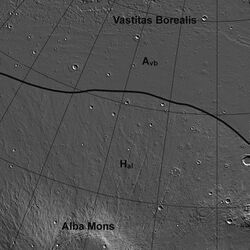Hesperian
Topic: Earth
 From HandWiki - Reading time: 12 min
From HandWiki - Reading time: 12 min
| Hesperian | |
|---|---|
| Template:Martian range | |
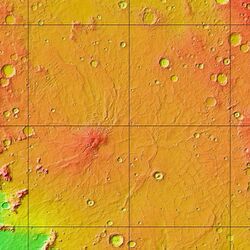 MOLA colorized relief map of Hesperia Planum, the type area for the Hesperian System. Note that Hesperia Planum has fewer large impact craters than the surrounding Noachian terrain, indicating a younger age. Colors indicate elevation, with red highest, yellow intermediate, and green/blue lowest. | |
| Chronology | |
| Subdivisions | Early Heperian Late Hesperian |
| Usage information | |
| Celestial body | Mars |
| Time scale(s) used | Martian Geologic Timescale |
| Definition | |
| Chronological unit | Period |
| Stratigraphic unit | System |
| Type section | Hesperia Planum |
The Hesperian is a geologic system and time period on the planet Mars characterized by widespread volcanic activity and catastrophic flooding that carved immense outflow channels across the surface. The Hesperian is an intermediate and transitional period of Martian history. During the Hesperian, Mars changed from the wetter and perhaps warmer world of the Noachian to the dry, cold, and dusty planet seen today.[1] The absolute age of the Hesperian Period is uncertain. The beginning of the period followed the end of the Late Heavy Bombardment[2] and probably corresponds to the start of the lunar Late Imbrian period,[3][4] around 3700 million years ago (Mya). The end of the Hesperian Period is much more uncertain and could range anywhere from 3200 to 2000 Mya,[5] with 3000 Mya being frequently cited. The Hesperian Period is roughly coincident with the Earth's early Archean Eon.[2]
With the decline of heavy impacts at the end of the Noachian, volcanism became the primary geologic process on Mars, producing vast plains of flood basalts and broad volcanic constructs (highland paterae).[6] By Hesperian times, all of the large shield volcanoes on Mars, including Olympus Mons, had begun to form.[7] Volcanic outgassing released large amounts of sulfur dioxide (SO2) and hydrogen sulfide (H2S) into the atmosphere, causing a transition in the style of weathering from dominantly phyllosilicate (clay) to sulfate mineralogy.[8] Liquid water became more localized in extent and turned more acidic as it interacted with SO2 and H2S to form sulfuric acid.[9][10]
By the beginning of the Late Hesperian the atmosphere had probably thinned to its present density.[10] As the planet cooled, groundwater stored in the upper crust (megaregolith) began to freeze, forming a thick cryosphere overlying a deeper zone of liquid water.[11] Subsequent volcanic or tectonic activity occasionally fractured the cryosphere, releasing enormous quantities of deep groundwater to the surface and carving huge outflow channels. Much of this water flowed into the northern hemisphere where it probably pooled to form large transient lakes or an ice covered ocean.
Description and name origin
The Hesperian System and Period is named after Hesperia Planum, a moderately cratered highland region northeast of the Hellas basin. The type area of the Hesperian System is in the Mare Tyrrhenum quadrangle (MC-22) around [ ⚑ ] 20°S 245°W / 20°S 245°W. The region consists of rolling, wind-streaked plains with abundant wrinkle ridges resembling those on the lunar maria. These "ridged plains" are interpreted to be basaltic lava flows (flood basalts) that erupted from fissures.[12] The number-density of large impact craters is moderate, with about 125–200 craters greater than 5 km in diameter per million km2.[3][13] Hesperian-aged ridged plains cover roughly 30% of the Martian surface;[2] they are most prominent in Hesperia Planum, Syrtis Major Planum, Lunae Planum, Malea Planum, and the Syria-Solis-Sinai Plana in southern Tharsis.[14][15] <timeline> ImageSize = width:800 height:50 PlotArea = left:15 right:15 bottom:20 top:5 AlignBars = early
Period = from:-4500 till:0 TimeAxis = orientation:horizontal ScaleMajor = unit:year increment:500 start:-4500 ScaleMinor = unit:year increment:100 start:-4500
Colors=
id:prenoachicol value:rgb(0.7,0.4,1) id:noachicol value:rgb(0.5,0.5,0.8) id:hespericol value:rgb(1,0.2,0.2) id:amazonicol value:rgb(1,0.5,0.2)
PlotData=
align:center textcolor:black fontsize:8 mark:(line,black) width:25 shift:(0,-5) text:Amazonian from:-3000 till:0 color:amazonicol text:Hesperian from:-3700 till:-3000 color:hespericol text:Noachian from:-4100 till:-3700 color:noachicol text:Pre-Noachian from:start till:-4100 color:prenoachicol
</timeline>
Hesperian chronology and stratigraphy
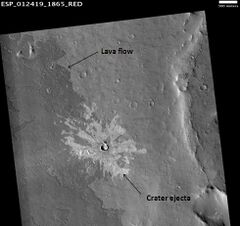
Martian time periods are based on geologic mapping of surface units from spacecraft images.[12][16] A surface unit is a terrain with a distinct texture, color, albedo, spectral property, or set of landforms that distinguish it from other surface units and is large enough to be shown on a map.[17] Mappers use a stratigraphic approach pioneered in the early 1960s for photogeologic studies of the Moon.[18] Although based on surface characteristics, a surface unit is not the surface itself or group of landforms. It is an inferred geologic unit (e.g., formation) representing a sheetlike, wedgelike, or tabular body of rock that underlies the surface.[19][20] A surface unit may be a crater ejecta deposit, lava flow, or any surface that can be represented in three dimensions as a discrete stratum bound above or below by adjacent units (illustrated right). Using principles such as superpositioning (illustrated left), cross-cutting relationships, and the relationship of impact crater density to age, geologists can place the units into a relative age sequence from oldest to youngest. Units of similar age are grouped globally into larger, time-stratigraphic (chronostratigraphic) units, called systems. For Mars, three systems are defined: the Noachian, Hesperian, and Amazonian. Geologic units lying below (older than) the Noachian are informally designated Pre-Noachian.[21] The geologic time (geochronologic) equivalent of the Hesperian System is the Hesperian Period. Rock or surface units of the Hesperian System were formed or deposited during the Hesperian Period.
System vs. period
| Segments of rock (strata) in chronostratigraphy | Periods of time in geochronology | Notes (Mars) |
|---|---|---|
| Eonothem | Eon | not used for Mars |
| Erathem | Era | not used for Mars |
| System | Period | 3 total; 108 to 109 years in length |
| Series | Epoch | 8 total; 107 to 108 years in length |
| Stage | Age | not used for Mars |
| Chronozone | Chron | smaller than an age/stage; not used by the ICS timescale |
System and period are not interchangeable terms in formal stratigraphic nomenclature, although they are frequently confused in popular literature. A system is an idealized stratigraphic column based on the physical rock record of a type area (type section) correlated with rocks sections from many different locations planetwide.[23] A system is bound above and below by strata with distinctly different characteristics (on Earth, usually index fossils) that indicate dramatic (often abrupt) changes in the dominant fauna or environmental conditions. (See Cretaceous–Paleogene boundary as example.)
At any location, rock sections in a given system are apt to contain gaps (unconformities) analogous to missing pages from a book. In some places, rocks from the system are absent entirely due to nondeposition or later erosion. For example, rocks of the Cretaceous System are absent throughout much of the eastern central interior of the United States. However, the time interval of the Cretaceous (Cretaceous Period) still occurred there. Thus, a geologic period represents the time interval over which the strata of a system were deposited, including any unknown amounts of time present in gaps.[23] Periods are measured in years, determined by radioactive dating. On Mars, radiometric ages are not available except from Martian meteorites whose provenance and stratigraphic context are unknown. Instead, absolute ages on Mars are determined by impact crater density, which is heavily dependent upon models of crater formation over time.[24] Accordingly, the beginning and end dates for Martian periods are uncertain, especially for the Hesperian/Amazonian boundary, which may be in error by a factor of 2 or 3.[4][21]
Boundaries and subdivisions
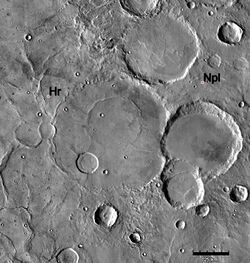
The lower boundary of the Hesperian System is defined as the base of the ridged plains, which are typified by Hesperia Planum and cover about a third of the planet's surface.[3] In eastern Hesperia Planum, the ridged plains overlie early to mid Noachian aged cratered plateau materials (pictured left).[15] The Hesperian's upper boundary is more complex and has been redefined several times based on increasingly detailed geologic mapping.[3][12][26] Currently, the stratigraphic boundary of the Hesperian with the younger Amazonian System is defined as the base of the Vastitas Borealis Formation[27] (pictured right). The Vastitas Borealis is a vast, low-lying plain that covers much of the northern hemisphere of Mars. It is generally interpreted to consist of reworked sediments originating from the Late Hesperian outflow channels and may be the remnant of an ocean that covered the northern lowland basins. Another interpretation of the Vastitas Borealis Formation is that it consists of lava flows.[28]
The Hesperian System is subdivided into two chronostratigraphic series: Lower Hesperian and Upper Hesperian. The series are based on referents or locations on the planet where surface units indicate a distinctive geological episode, recognizable in time by cratering age and stratigraphic position. For example, Hesperia Planum is the referent location for the Lower Hesperian Series.[3][29] The corresponding geologic time (geochronological) units of the two Hesperian series are the Early Hesperian and Late Hesperian Epochs. An epoch is a subdivision of a period; the two terms are not synonymous in formal stratigraphy. The age of the Early Hepserian/Late Hesperian boundary is uncertain, ranging from 3600 to 3200 million years ago based on crater counts.[5] The average of the range is shown in the timeline below.
<timeline> ImageSize = width:800 height:50 PlotArea = left:15 right:15 bottom:20 top:5 AlignBars = early
Period = from:-3700 till:-3000 TimeAxis = orientation:horizontal ScaleMajor = unit:year increment:100 start:-3700 ScaleMinor = unit:year increment:10 start:-3700
Colors=
id:Ehespericol value:rgb(1,0.5,0.2) id:Lhespericol value:rgb(1,1,0.2)
PlotData=
align:center textcolor:black fontsize:8 mark:(line,black) width:25 shift:(0,-5)
text:Late_Hesperian from:-3400 till:-3000 color:Lhespericol text:Early_Hesperian from:start till:-3400 color:Ehespericol
</timeline>
Stratigraphic terms are typically confusing to geologists and non-geologists alike. One way to sort through the difficulty is by the following example: One could easily go to Cincinnati, Ohio and visit a rock outcrop in the Upper Ordovician Series of the Ordovician System. You could even collect a fossil trilobite there. However, you could not visit the Late Ordovician Epoch in the Ordovician Period and collect an actual trilobite.
The Earth-based scheme of rigid stratigraphic nomenclature has been successfully applied to Mars for several decades now but has numerous flaws. The scheme will no doubt become refined or replaced as more and better data become available.[30] (See mineralogical timeline below as example of alternative.) Obtaining radiometric ages on samples from identified surface units is clearly necessary for a more complete understanding of Martian chronology.[31]
Mars during the Hesperian Period
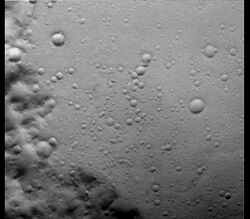
The Hesperian was a time of declining rates of impact cratering, intense and widespread volcanic activity, and catastrophic flooding. Many of the major tectonic features on Mars formed at this time. The weight of the immense Tharsis Bulge stressed the crust to produce a vast network of extensional fractures (fossae) and compressive deformational features (wrinkle ridges) throughout the western hemisphere. The huge equatorial canyon system of Valles Marineris formed during the Hesperian as a result of these stresses. Sulfuric-acid weathering at the surface produced an abundance of sulfate minerals that precipitated in evaporitic environments, which became widespread as the planet grew increasingly arid. The Hesperian Period was also a time when the earliest evidence of glacial activity and ice-related processes appears in the Martian geologic record.
Impact cratering
As originally conceived, the Hesperian System referred to the oldest surfaces on Mars that postdate the end of heavy bombardment.[33] The Hesperian was thus a time period of rapidly declining impact cratering rates. However, the timing and rate of the decline are uncertain. The lunar cratering record suggests that the rate of impacts in the inner Solar System during the Noachian (4000 million years ago) was 500 times higher than today.[34] Planetary scientists still debate whether these high rates represent the tail end of planetary accretion or a late cataclysmic pulse that followed a more quiescent period of impact activity. Nevertheless, at the beginning of the Hesperian, the impact rate had probably declined to about 80 times greater than present rates,[4] and by the end of the Hesperian, some 700 million years later, the rate began to resemble that seen today.[35]
Notes and references
- ↑ Hartmann, 2003, pp. 33–34.
- ↑ 2.0 2.1 2.2 Carr, M. H.; Head, J. W. (2010). "Geologic history of Mars". Earth and Planetary Science Letters 294 (3–4): 185–203. doi:10.1016/j.epsl.2009.06.042. Bibcode: 2010E&PSL.294..185C. https://zenodo.org/record/1258929.
- ↑ 3.0 3.1 3.2 3.3 3.4 Tanaka, K. L. (1986). "The stratigraphy of Mars". Journal of Geophysical Research 91 (B13): E139–E158. doi:10.1029/JB091iB13p0E139. Bibcode: 1986LPSC...17..139T. https://zenodo.org/record/1231412.
- ↑ 4.0 4.1 4.2 Hartmann, W. K.; Neukum, G. (2001). "Cratering Chronology and the Evolution of Mars". Space Science Reviews 96: 165–194. doi:10.1023/A:1011945222010. Bibcode: 2001SSRv...96..165H.
- ↑ 5.0 5.1 5.2 Hartmann, W. K. (2005). "Martian cratering 8: Isochron refinement and the chronology of Mars". Icarus 174 (2): 294–320. doi:10.1016/j.icarus.2004.11.023. Bibcode: 2005Icar..174..294H.
- ↑ Greeley, R.; Spudis, P. D. (1981). "Volcanism on Mars". Reviews of Geophysics 19 (1): 13–41. doi:10.1029/RG019i001p00013. Bibcode: 1981RvGSP..19...13G.
- ↑ Werner, S. C. (2009). "The global martian volcanic evolutionary history". Icarus 201 (1): 44–68. doi:10.1016/j.icarus.2008.12.019. Bibcode: 2009Icar..201...44W.
- ↑ Bibring, J.-P.; Langevin, Y.; Mustard, J. F.; Poulet, F.; Arvidson, R.; Gendrin, A.; Gondet, B.; Mangold, N. et al. (2006). "Global Mineralogical and Aqueous Mars History Derived from OMEGA/Mars Express Data". Science 312 (5772): 400–404. doi:10.1126/science.1122659. PMID 16627738. Bibcode: 2006Sci...312..400B.
- ↑ Head, J.W.; Wilson, L. (2011). The Noachian-Hesperian Transition on Mars: Geological Evidence for a Punctuated Phase of Global Volcanism as a Key Driver in Climate and Atmospheric Evolution. 42nd Lunar and Planetary Science Conference (2011), Abstract #1214. http://www.lpi.usra.edu/meetings/lpsc2011/pdf/1214.pdf.
- ↑ 10.0 10.1 Barlow, N. G. (2010). "What we know about Mars from its impact craters". Geological Society of America Bulletin 122 (5–6): 644–657. doi:10.1130/B30182.1. Bibcode: 2010GSAB..122..644B.
- ↑ Clifford, S. M. (1993). "A model for the hydrologic and climatic behavior of water on Mars". Journal of Geophysical Research 98 (E6): 10973–11016. doi:10.1029/93JE00225. Bibcode: 1993JGR....9810973C.
- ↑ 12.0 12.1 12.2 Scott, D.H.; Carr, M.H. (1978). Geologic Map of Mars. U.S. Geological Survey Miscellaneous Investigations Series Map I-1083.
- ↑ Strom, R.G.; Croft, S.K.; Barlow, N.G. (1992) The Martian Impact Cratering Record in Mars, H.H. Kieffer et al., Eds.; University of Arizona Press: Tucson, AZ, pp. 383–423.
- ↑ Scott, D.H.; Tanaka, K.L. (1986). Geologic Map of the Western Equatorial Region of Mars. U.S. Geological Survey Miscellaneous Investigations Series Map I–1802–A.
- ↑ 15.0 15.1 Greeley, R.; Guest, J.E. (1987). Geologic Map of the Eastern Equatorial Region of Mars. U.S. Geological Survey Miscellaneous Investigations Series Map I–1802–B.
- ↑ McCord, T.M. et al. (1980). Definition and Characterization of Mars Global Surface Units: Preliminary Unit Maps. 11th Lunar and Planetary Science Conference: Houston: TX, abstract #1249, pp. 697–699. http://www.lpi.usra.edu/meetings/lpsc1980/pdf/1249.pdf.
- ↑ Greeley, R. (1994) Planetary Landscapes, 2nd ed.; Chapman & Hall: New York, p. 8 and Fig. 1.6.
- ↑ See Mutch, T.A. (1970). Geology of the Moon: A Stratigraphic View; Princeton University Press: Princeton, NJ, 324 pp. and Wilhelms, D.E. (1987). The Geologic History of the Moon, USGS Professional Paper 1348; http://ser.sese.asu.edu/GHM/ for reviews of this topic.
- ↑ Wilhelms, D.E. (1990). Geologic Mapping in Planetary Mapping, R. Greeley, R.M. Batson, Eds.; Cambridge University Press: Cambridge UK, p. 214.
- ↑ Tanaka, K.L.; Scott, D.H.; Greeley, R. (1992). Global Stratigraphy in Mars, H.H. Kieffer et al., Eds.; University of Arizona Press: Tucson, AZ, pp. 345–382.
- ↑ 21.0 21.1 Nimmo, F.; Tanaka, K. (2005). "Early Crustal Evolution of Mars". Annual Review of Earth and Planetary Sciences 33 (1): 133–161. doi:10.1146/annurev.earth.33.092203.122637. Bibcode: 2005AREPS..33..133N.
- ↑ International Commission on Stratigraphy. "International Stratigraphic Chart". http://www.stratigraphy.org/upload/ISChart2009.pdf. Retrieved 2009-09-25.
- ↑ 23.0 23.1 Eicher, D.L.; McAlester, A.L. (1980). History of the Earth; Prentice-Hall: Englewood Cliffs, NJ, pp 143–146, ISBN:0-13-390047-9.
- ↑ Masson, P.; Carr, M.H.; Costard, F.; Greeley, R.; Hauber, E.; Jaumann, R. (2001). "Geomorphologic Evidence for Liquid Water". Space Science Reviews. Space Sciences Series of ISSI 96: 333–364. doi:10.1007/978-94-017-1035-0_12. ISBN 978-90-481-5725-9.
- ↑ Ivanov, M. A.; Head, J. W. (2006). "Alba Patera, Mars: Topography, structure, and evolution of a unique late Hesperian–early Amazonian shield volcano". Journal of Geophysical Research 111 (E9): E09003. doi:10.1029/2005JE002469. Bibcode: 2006JGRE..111.9003I.
- ↑ Tanaka, K.L.; Skinner, J.A.; Hare, T.M. (2005). Geologic Map of the Northern Plains of Mars. Scientific Investigations Map 2888, Pamphlet; U.S. Geological Survey.
- ↑ The Vastitas Borealis Formation is used here to include the Lower Amazonian Scandia, Vastitas Borealis interior, and Vastitas Borealis marginal units of Tanaka et al. (2005).
- ↑ Catling, D.C.; Leovy, C.B.; Wood, S.E.; Day, M.D. (2011). A Lava Sea in the Northern Plains of Mars: Circumpolar Hesperian Oceans Reconsidered. 42nd Lunar and Planetary Science Conference, Abstract #2529. http://www.lpi.usra.edu/meetings/lpsc2011/pdf/2529.pdf.
- ↑ Masson, P. L. (1991). "The Martian stratigraphy — Short review and perspectives". Space Science Reviews 56 (1–2): 9–12. doi:10.1007/BF00178385. Bibcode: 1991SSRv...56....9M.
- ↑ Tanaka, K.L. (2001). The Stratigraphy of Mars: What We Know, Don't Know, and Need to Do. 32nd Lunar and Planetary Science Conference, Abstract #1695. http://www.lpi.usra.edu/meetings/lpsc2001/pdf/1695.pdf.
- ↑ Carr, 2006, p. 41.
- ↑ Carr, M.H. (1996). Water on Mars; Oxford University Press: Oxford, UK, 229 pp, ISBN:0-19-509938-9.
- ↑ Carr, 2006, p. 15.
- ↑ Carr, 2006, p. 23.
- ↑ Fassett, C. I.; Head, J. W. (2011). "Sequence and timing of conditions on early Mars". Icarus 211 (2): 1204–1214. doi:10.1016/j.icarus.2010.11.014. Bibcode: 2011Icar..211.1204F.
Bibliography and recommended reading
- Boyce, Joseph M. (2008). The Smithsonian Book of Mars. Old Saybrook, CT: Konecky & Konecky. ISBN 978-1-58834-074-0. https://archive.org/details/smithsonianbooko00boyc.
- Carr, Michael H. (2006). The Surface of Mars. Cambridge, UK: Cambridge University Press. ISBN 978-0-521-87201-0.
- Hartmann, William K. (2003). A Traveler's Guide to Mars: The Mysterious Landscapes of the Red Planet. New York: Workman. ISBN 0-7611-2606-6. https://archive.org/details/travelersguideto00will.
- Morton, Oliver (2003). Mapping Mars: Science, Imagination, and the Birth of a World. New York: Picador. ISBN 0-312-42261-X. https://archive.org/details/mappingmars00oliv.
 |
 KSF
KSF